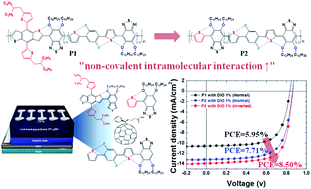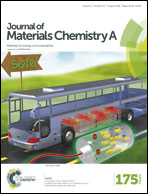A feasible random copolymer approach for high-efficiency polymeric photovoltaic cells†
Abstract
Two random copolymers based on (2,5-difluorophenylene)dithiophene and dialkoxybenzothiadiazole with benzodithiophene (P1) or thiophene (P2) as the third conjugated bridge having sulfur and fluorine (S⋯F) and/or oxygen (S⋯O) non-covalent intramolecular interaction are synthesized and characterized. In spite of a molecular weight difference over three times between both polymers, P1 and P2 possess similar solubility in organic solvents and thermal stability (Td ∼ 320 °C), which means probably due to that P1 with bulky alkylthiophene substituted benzodithiophene as a third conjugated bridge has less non-covalent intramolecular interaction than that of P2 with thiophene as a bridge. Both polymers were used as electron donors in bulk heterojunction organic photovoltaics (BHJ OPV) with PC71BM as an acceptor. From the photovoltaic measurements it was revealed that P2 shows higher power conversion efficiency (PCE) of up to 6.82% than that of P1 (2.44%). After 1,8-diiodooctane (DIO) treatments as a processing additive, the P1 and P2 devices show a significantly improved PCE of 5.95% for P1 and 7.71% for P2. The surface morphology analysis of the blend films using the atomic force microscope (AFM) reveals that the P1 : PC71BM film shows macrophase separation, while the P2 film has a smooth morphology. After DIO treatments, the morphology of both polymer blend films is improved with better bi-continuous nanoscale networks. Charge carrier mobilities through the space charge limited current (SCLC) method demonstrate that P2 with the thiophene bridge has higher charge carrier mobilities than P1. In particular, an inverted structured BHJ OPV with P2 exhibits a PCE of 8.50%, which is the highest PCE reported in the literature regarding random copolymers.


 Please wait while we load your content...
Please wait while we load your content...